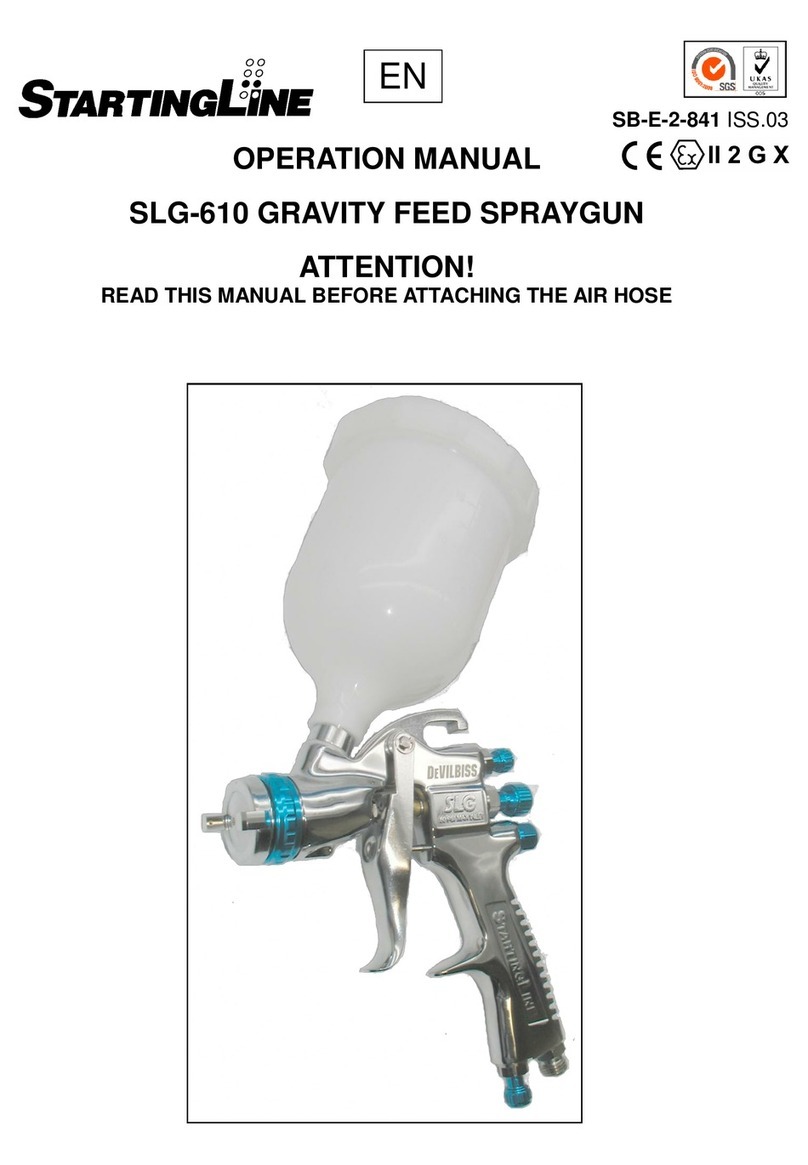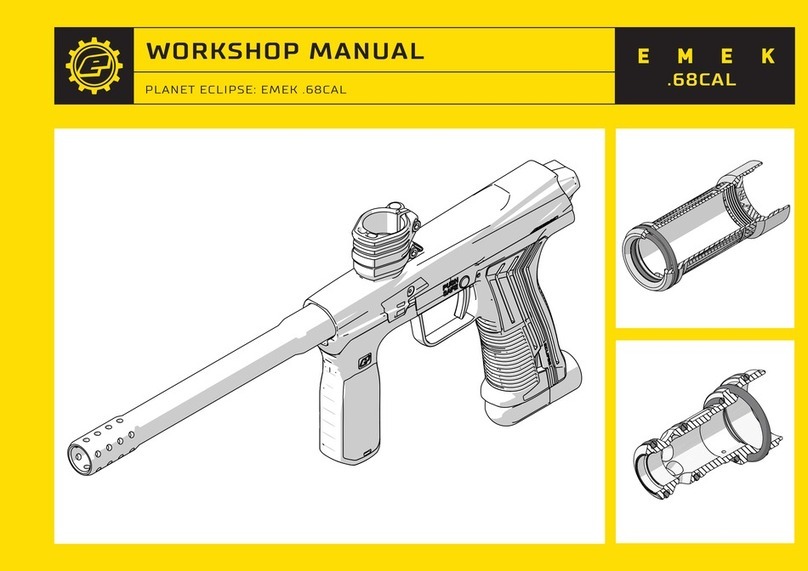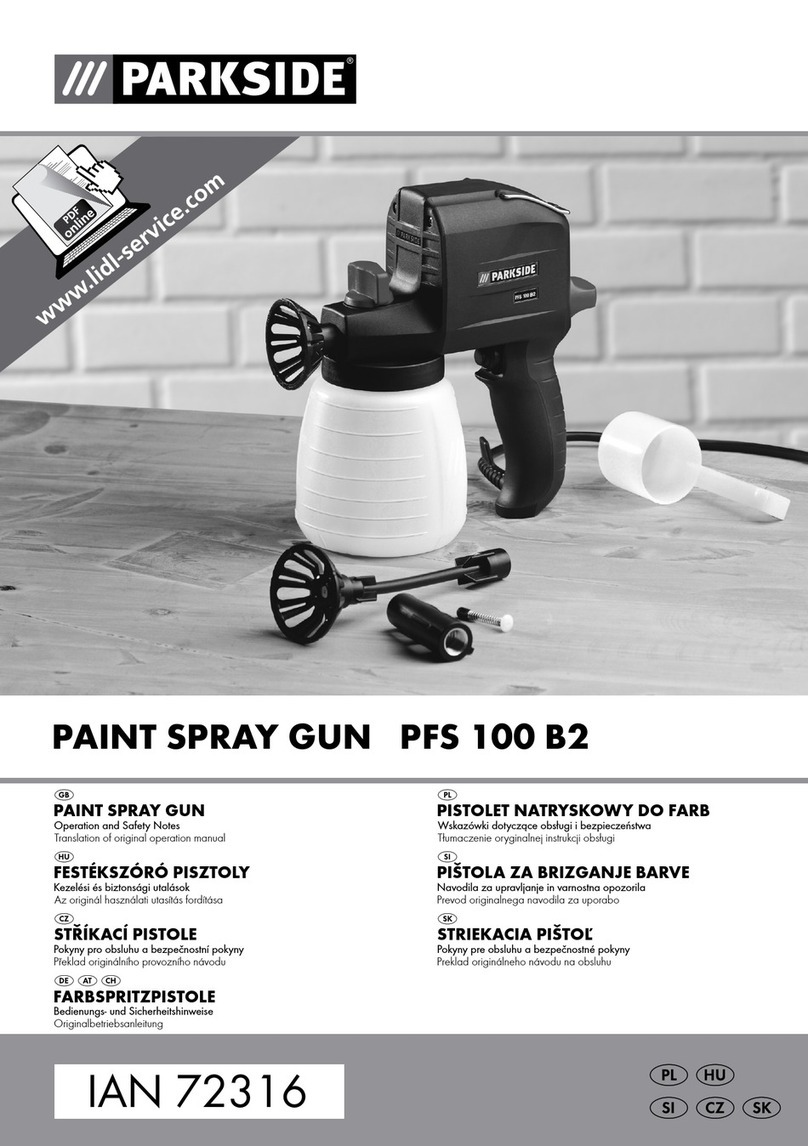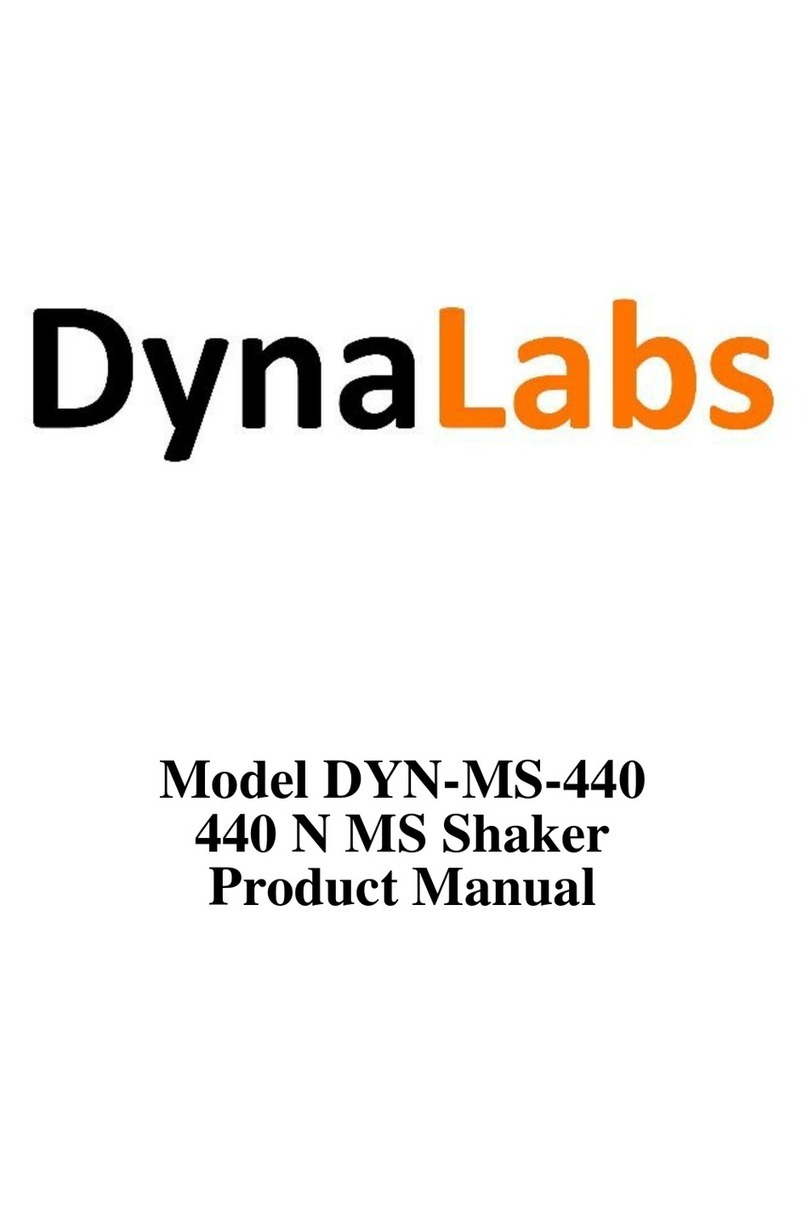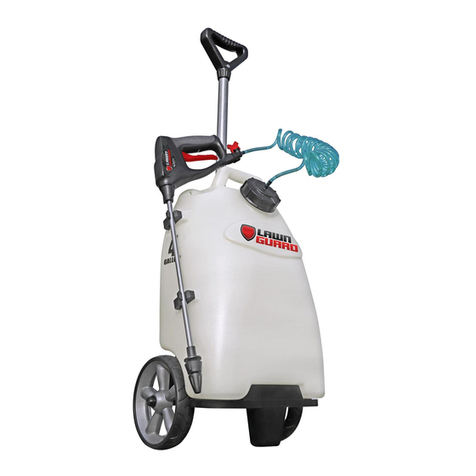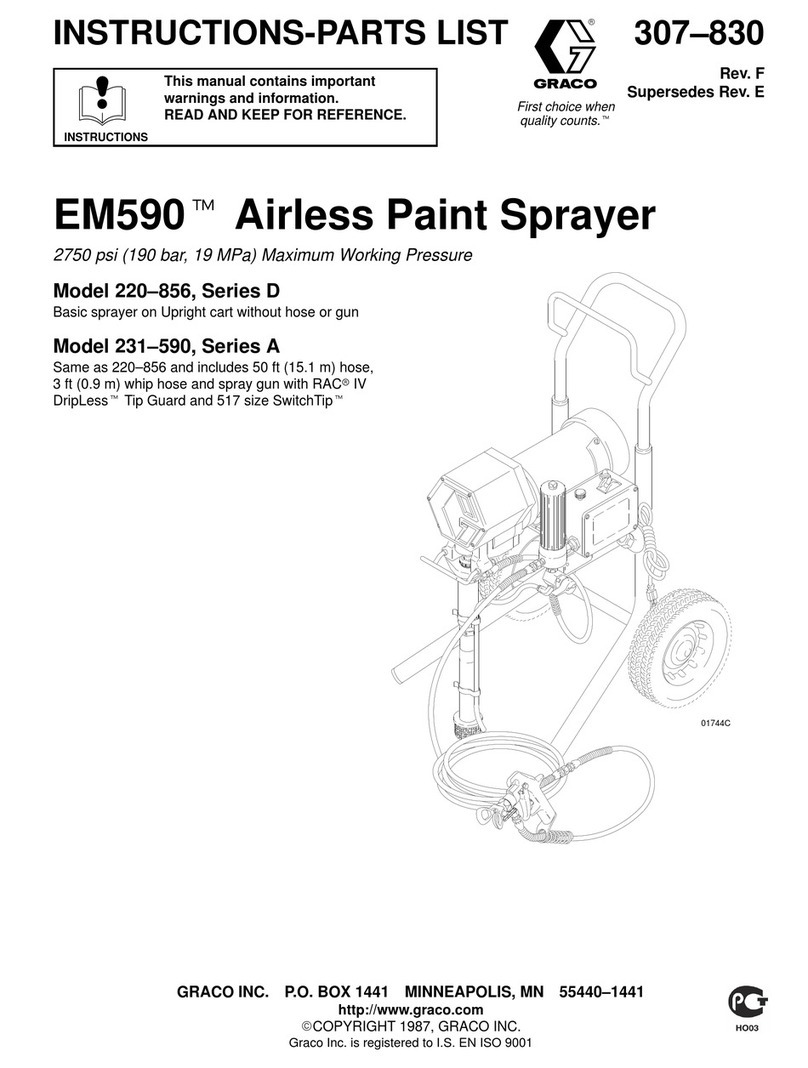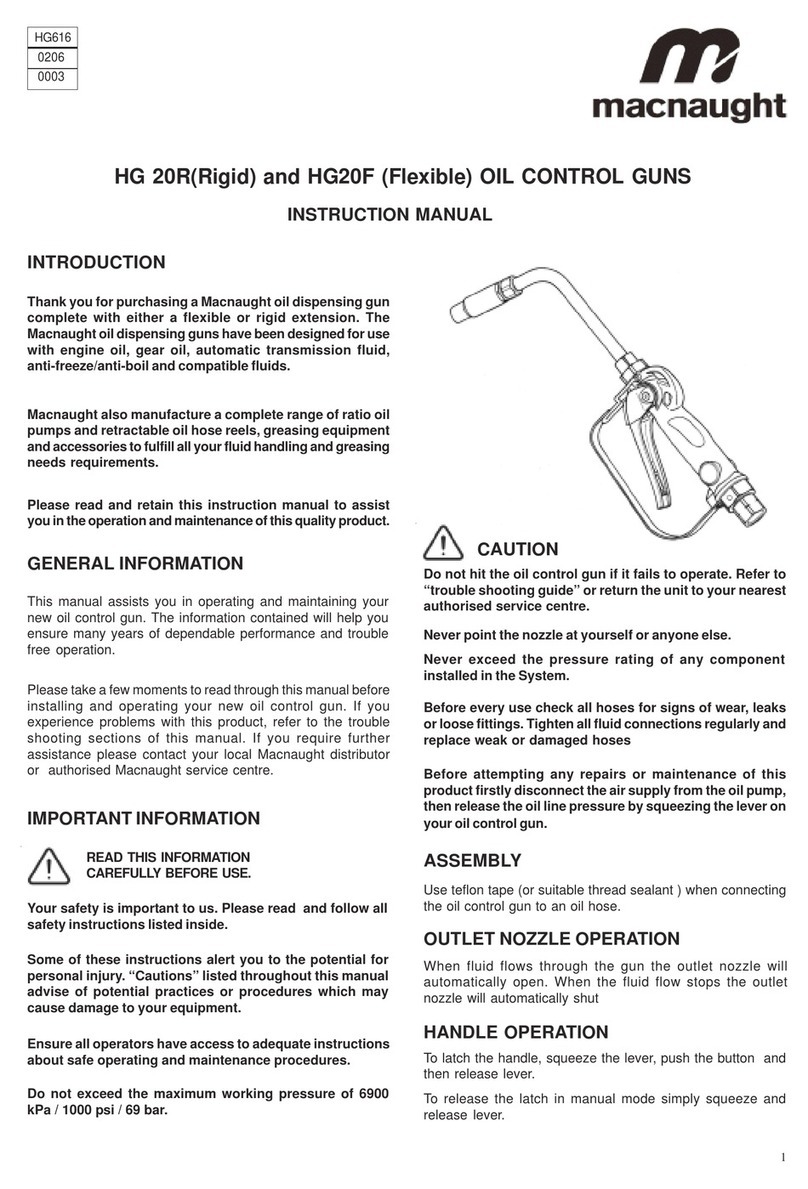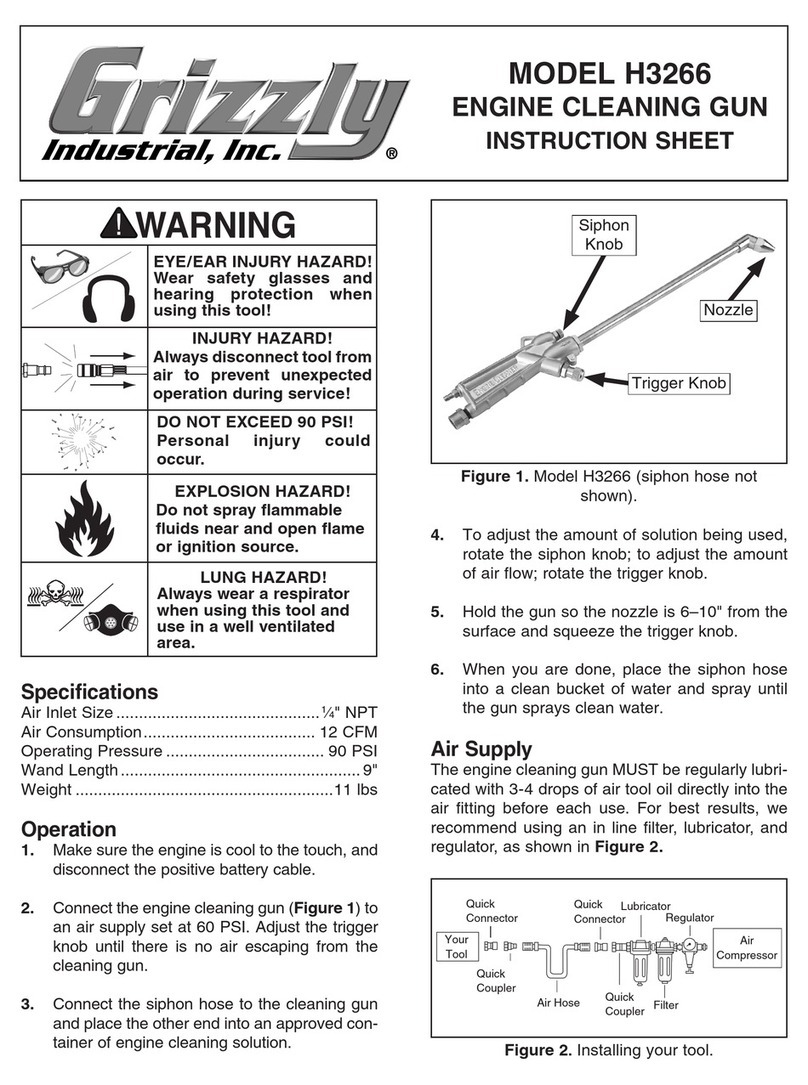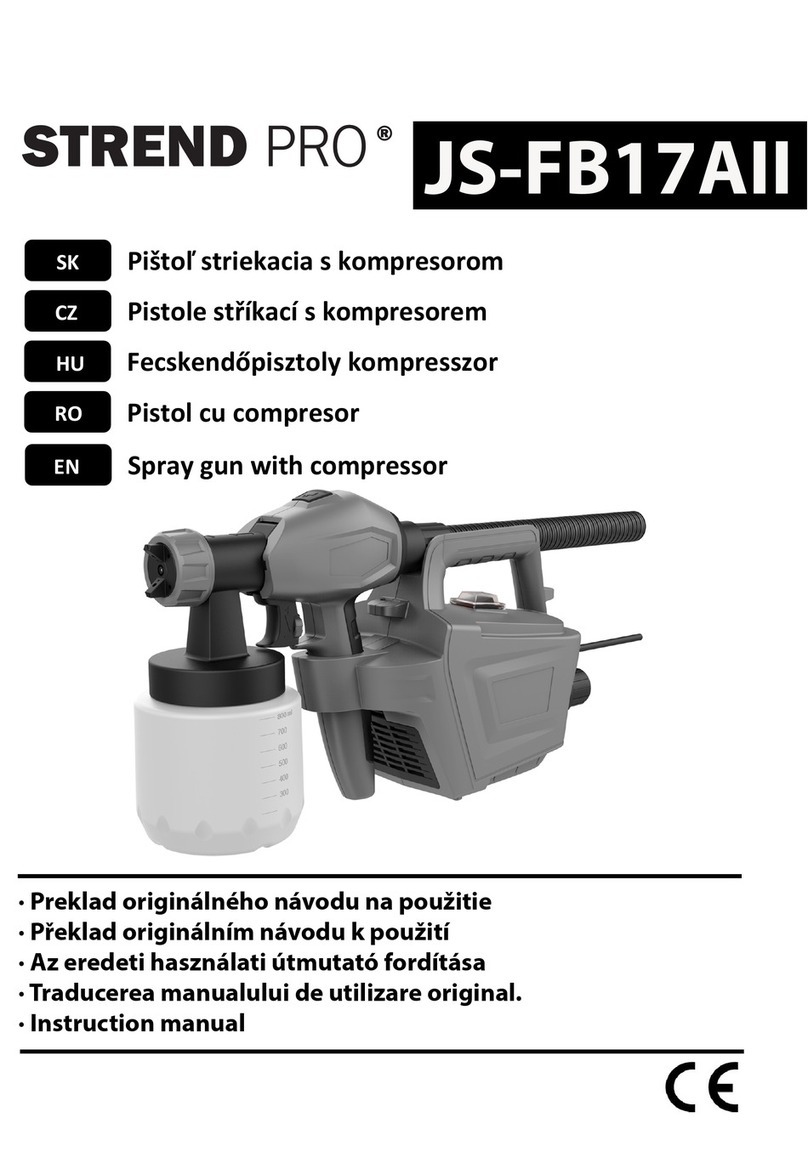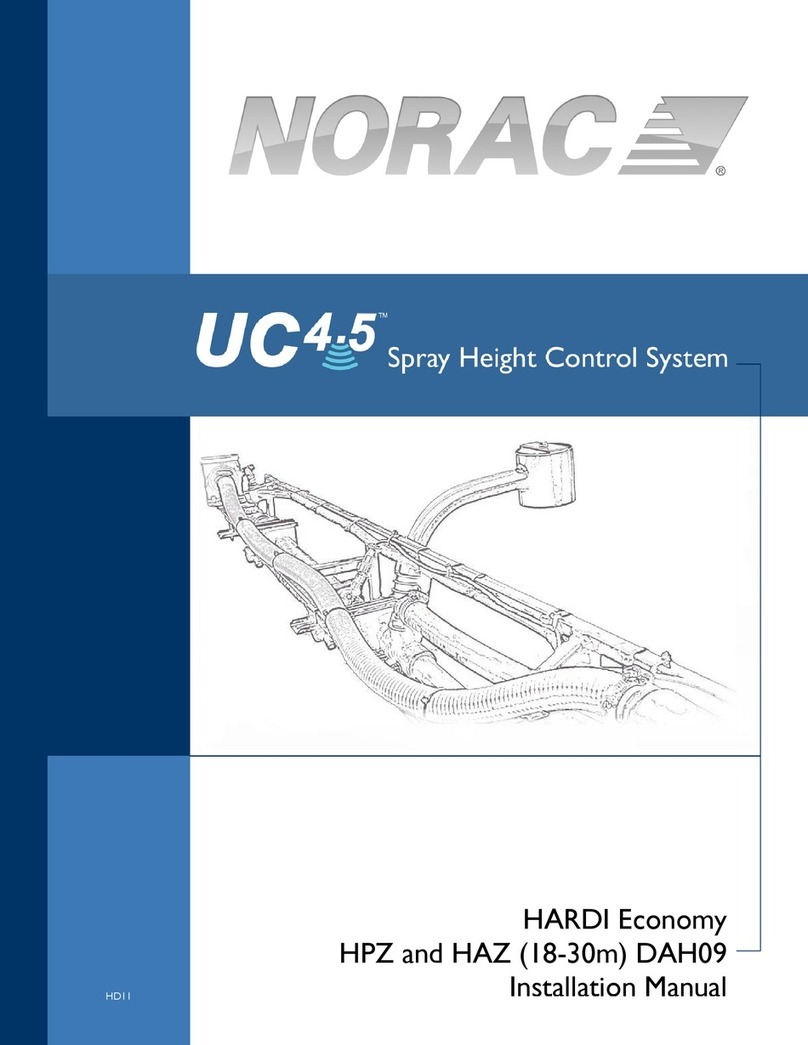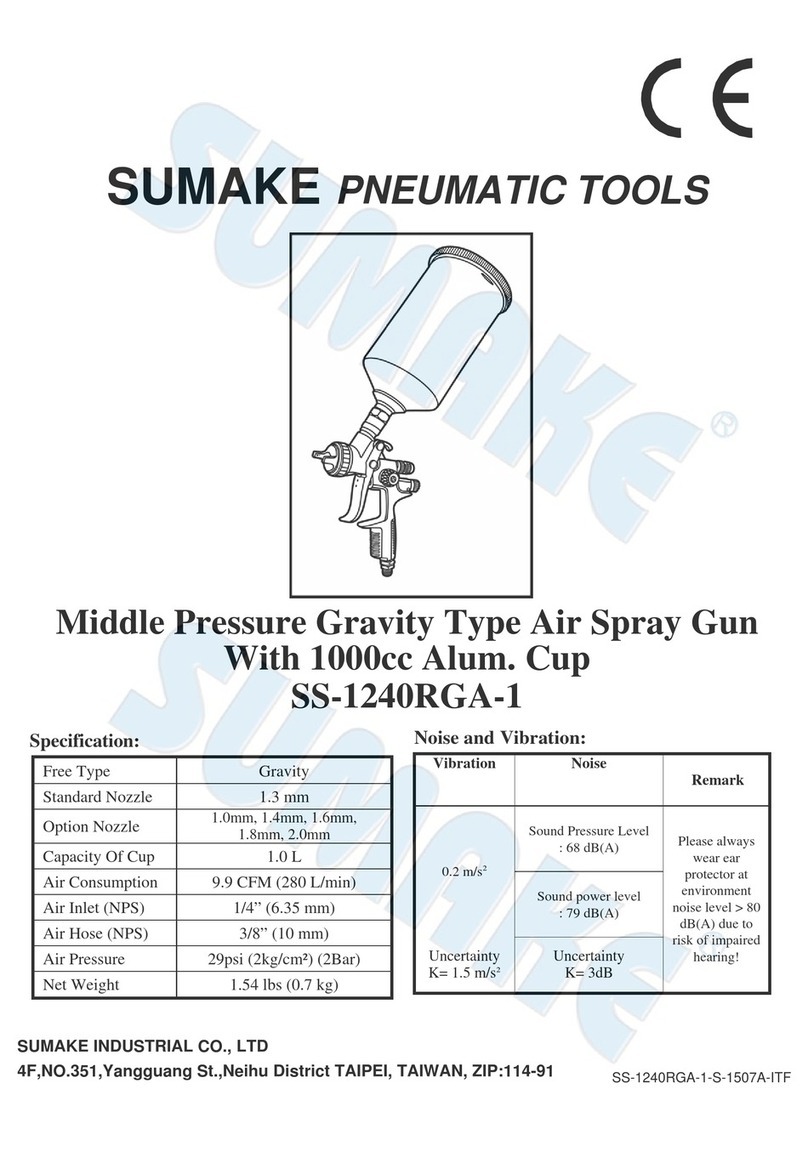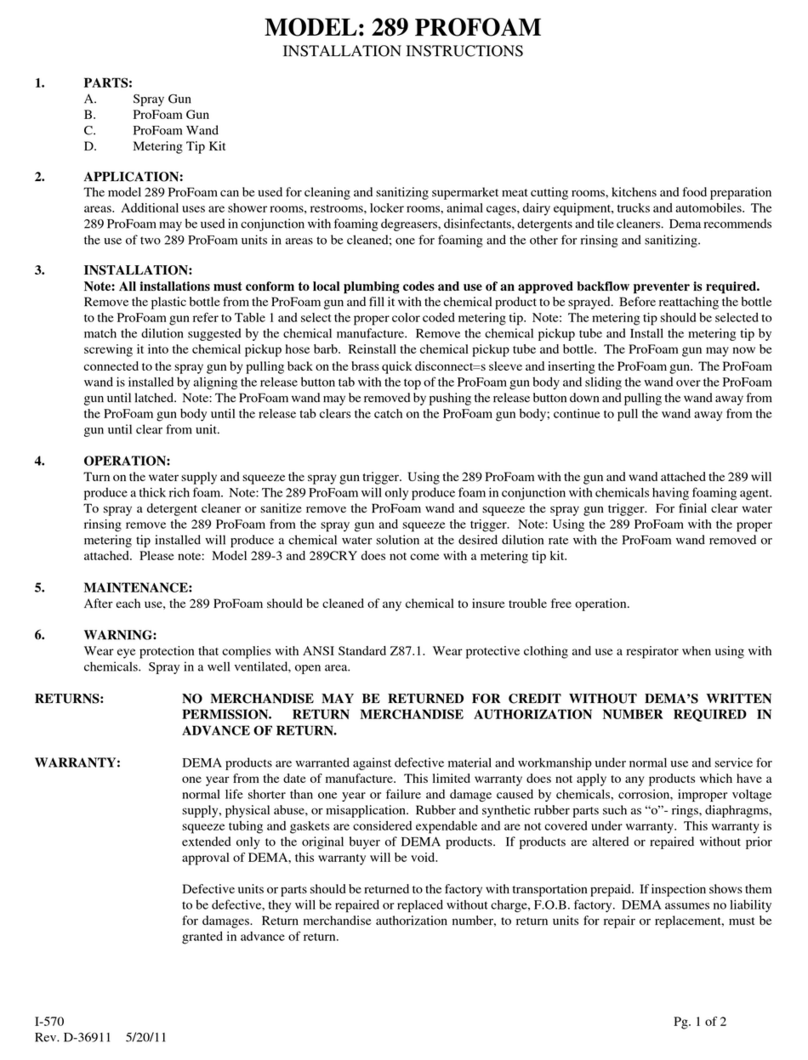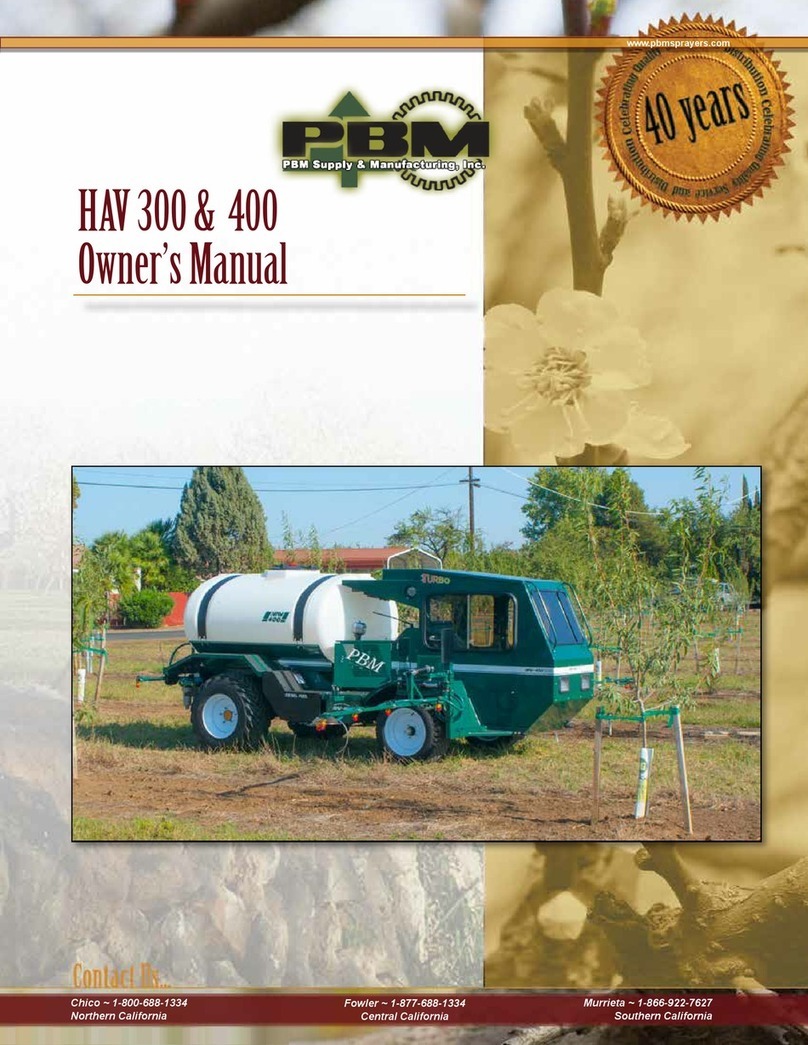StartingLine SLG-P500 User manual

SB-E-2-840 ISS.02
OPERATION MANUAL
SLG-P500 PRESSURE FEED SPRAYGUN
ATTENTION!
READ THIS MANUAL BEFORE ATTACHING THE AIR OR FLUID HOSE
EN

2
The following hazards may occur during the normal use of this equipment. Please read the following chart.
HAZARD
CAUSE
SAFEGUARDS
Fire
Solvent and coatings can be highly flammable
or combustible especially when sprayed.
Adequate exhaust must be provided to keep air free of
accumulations of flammable vapours.
Smoking must never be allowed in the spray area.
Fire extinguishing equipment must be present in the spray
area.
Solvent Spray
During use and while cleaning and flushing,
solvents can be forcefully expelled from fluid
and air passages. Some solvents can cause
eye injury.
Wear eye protection.
Inhaling Toxic
Substances
Certain materials may be harmful if inhaled, or
if there is contact with the skin.
Follow the requirements of the Material Safety Data Sheet
supplier by the coating manufacturer.
Adequate exhaust must be provided to keep the air free of
accumulations of toxic materials.
Use a mask or respirator wherever there is a chance of
inhaling sprayed materials. The mask must be compatible
with the material being sprayed and its concentration.
Equipment must be as prescribed by an industrial hygienist or
safety expert, and comply with all local regulations
Explosion Hazard -
Incompatible Materials
Halogenated hydrocarbon solvents—for
example; methylene chloride and
1,1,1–Trichloroethane are not chemically
compatible with the aluminium that might be
used in many system components. The
chemical reaction caused by these solvents
reacting with aluminium can become violent
and lead to an equipment explosion.
Guns with stainless steel internal passages may be used with
these solvents. However,
Aluminium is widely used in other spray application
equipment—such as material pumps, regulators, valves and
this gun and cup.
Check all equipment items before use and make sure they
can also be used safely with these solvents. Read the label or
data sheet for the material you intend to spray. If in doubt as
to whether or not a coating or cleaning material is compatible,
contact your material supplier
GENERAL SAFETY
Improper operation or maintenance of
equipment.
Operators should be given adequate training in the safe use
and maintenance of the equipment. Users must comply with
all local and national codes of practice and insurance
company requirements governing ventilation, fire precautions,
operation, maintenance and housekeeping.
Cumulative Trauma
disorders (“CTD’s)
CTD’s or
musculoskeletal
disorders, involve
damage to wrists,
elbows, shoulders,
neck and back. Carpal
tunnel syndrome and
tendonitis (such as
tennis elbow or rotator
cuff syndrome) are
examples of CTD’s
Use of hand tools may cause cumulative
trauma disorders (―CTD’s)
CTD’s when using hand tools, tend to affect
the upper extremities. Factors which may
increase the risk of developing a CTD include:
1. High frequency of activity.
2. Excessive force such as gripping, pinching
or pressing with the hands and fingers.
3. Extreme or awkward finger, wrist, or arm
positions.
4. Excessive duration of the activity.
5. Tool vibration
6. Repeated pressure on a body part.
7. Working in cold temperatures.
CTD’s can also be caused by such activities
as sewing, golf and bowling to name a few.
Pain, tingling, or numbness in the shoulder, forearm wrist
hands, or fingers, especially during the night, may be early
symptoms of a CTD. Do not ignore them .Should you
experience any such symptoms see a physician immediately.
Other early symptoms may include vague discomfort in the
hand, loss of manual dexterity and non-specific pain in the
arm. Ignoring early symptoms and continued repetitive use of
the arm, wrist and hand can lead to serious disability. Risk is
reduced by avoiding or lessening factors 1—7

3
ATTENTION!
READ BEFORE ATTACHING THE AIR OR FLUID HOSE
SET-UP AND ADJUSTMENT INSTRUCTIONS
1. Attach Fluid Hose to Gun and flush through with
cleaning solvent to remove oils.
2. Adjust packing nut (see packing adjustment
instructions).
3. Fully open fan and fluid needle controls (turn
counter-clockwise).
4. If desired, attach air adjusting valve with gauge
and/or quick disconnect to air inlet, then attach
hose. Recommended air pressure 45psi (3.0 bar).
5. Set Fluid pressure 5—10 psi depending on type of
coating material.
6. Spray test and adjust air pressure, fan size and fluid
flow as required. Recommended spray distance 6 –
8 inches (150—200mm).
7. Do not exceed maximum pressure of 60psi (4 bar)
for air or fluid pressure.
8. Ensure materials to be sprayed are compatible with
this spray gun.
A failure resulting in injury or damage may be caused by pressure exceeding the maximum air of fluid
pressure, excessive vibration or pressure pulsation, excessive temperature, corrosion of the pressure
containing parts or other misuse of this spray gun.
PACKING ADJUSTMENT INSTRUCTIONS
Before using this spray gun, the packing nut should
be adjusted as follows;
1. Tighten packing nut until fluid needle starts to
bind in the packing.
2. Loosen packing nut just enough so the fluid
needle moves freely.
The packing nut is intentionally left loose so the
PTFE packing does not take a ―set‖ before the
spray gun is used. This allows full utilisation of the
packing.
OPERATION
1. Spray test an area. Turn the fluid needle adjusting
knob counter clockwise until a full coat is obtained.
2. If the finish is too sandy and dry, the material flow
may be too low for the atomising air pressure
being used. Turn the fluid needle adjusting knob
counter clockwise (out) to increase the fluid flow. If
the fluid flow is still not enough then increase the
fluid pressure from the paint cup/pot.
3. If the finish sags there is too much material flowing
for the atomisation air pressure being used. Turn the
fluid needle adjusting screw clockwise (in) to
decrease the fluid flow, or
reduce the pressure in the paint pressure
cup/pot.
4. The pattern width can be altered by turning the
fan control clockwise (in) to decrease the width
or counter clockwise to increase the width.
5. Adjust the inlet air pressure to provide a uniform
dispersion of atomised paint throughout the
pattern. Keep the air pressure as low as
possible to minimise bounce-back and
overspray. Excessive pressure will result in split
spray patterns. Inadequate pressure will cause
heavy cantered patterns and poor atomisation.

4
Finishing Brands UK Limited,
Ringwood Road,
Bournemouth,
BH11 9LH,
UK.
Tel.No: 01202 571111
Fax No: 01202 581940
Website address: http://
www.finishingbrands.eu
CLEANING
1. For routine cleaning, it is not necessary to remove
cup from gun. Remove lid and properly dispose
of any excess paint. Pour in a small amount of
clean solvent. The amount will vary with different
coatings and solvents. Reinstall lid. Shake cup to
wash down the inside surfaces. Pull trigger to
allow some solvent to be flushed through gun.
Remove lid and pour out dirty solvent. Add a
small amount of clean solvent and repeat
procedure. Wipe exterior of lid with a clean cloth
and clean solvent.
2.
If a paint filter was used in the bottom of the cup
outlet, it should be removed and cleaned at this
time.
3. To clean air cap and fluid tip, brush exterior with a
stiff bristle brush. If necessary to clean cap holes,
use a broom straw or toothpick if possible. If a
wire or hard instrument is used, extreme care
must be used to prevent scratching or burring of
the holes which will cause a distorted spray
pattern.
4.
To clean fluid passages, remove excess material
at source, then flush with a suitable solvent. Wipe
gun exterior with a solvent dampened cloth.
Never completely immerse in solvent as this is
detrimental to the lubricants and packings.
PREVENTATIVE MAINTENANCE
Spray Gun Lubrication
1.
Apply a drop of SSL-10 spray gun lube at trigger
bearing stud and the stem of the air valve. The
shank of the fluid needle where it enters the
packing nut should also be oiled. The fluid needle
packing should be kept soft and pliable by
periodic lubrication.
2. Make sure the baffle and retaining ring threads are
clean and free of foreign matter. Before assembling
retaining ring to baffle, clean the threads
thoroughly, then add two drops of SSL-10 spray
gun lube to threads.
3. The fluid needle spring and air valve spring should
be coated with a very light grease, making sure that
any excess grease will not clog the air passages.
For best results, lubricate the points indicated,
daily.
A. Trigger Points
B. Packing
C. Adjusting Valves
D. Baffle/Air Cap Threads
E. Needle adjusting knob and spring (inside knob).
Registered office:
Finishing Brands UK Limited,
400, Capability Green,
Luton,
Bedfordshire,
LU1 3AE,
UK.
Registered in England No: 07656273
Vat No: GB 113 5531 50
Other StartingLine Paint Sprayer manuals

